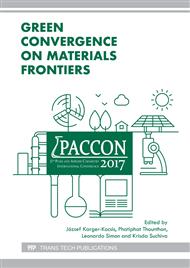p.14
p.19
p.24
p.29
p.35
p.40
p.46
p.52
p.57
Application of Dry Grass for Clay Brick Manufacturing
Abstract:
In this paper, effects of incorporation of dry grass on the properties of clay bricks were investigated. Clay bricks fabricated with 0, 2.5, 5 and 7.5 % (w/w) of dry grass were tested. The clay brick specimens were fired at 900, 1000 and 1100 °C to study for bulk density, apparent porosity water absorption and compressive strength of brick samples were investigated. Results revealed that the bulk density of clay bricks were reduced when dry grass dosages increased. Results also shown that the increasing in bulk density were obtained when the firing temperature increased. The compressive strength of clay bricks was decreased when dry grass dosages increased. The addition of 2.5 % (w/w) dry grass fired at 1100 °C showed the optimal condition which indicated 11.6 MPa of compressive strength and 1.78 g/cm3 of bulk density. However, results indicated that a decrease in water absorption and apparent porosity were found when the firing temperature increased. Test results also revealed that the addition of dry grass for clay brick production lead to utilize a potential material as the additive to raw clay-bricks in the manufacturing of lightweight clay bricks.
Info:
Periodical:
Pages:
35-39
Citation:
Online since:
October 2017
Authors:
Price:
Сopyright:
© 2017 Trans Tech Publications Ltd. All Rights Reserved
Share:
Citation:


